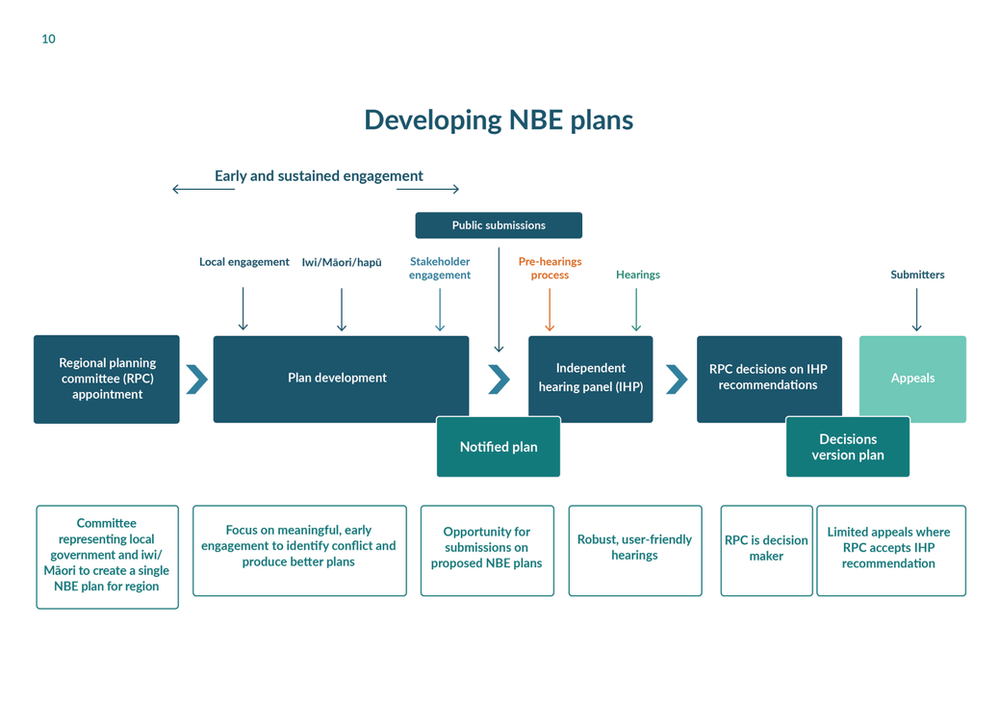The Natural and Built Environment Act (NBEA) is one of the three Acts that will replace the Resource Management Act (RMA) as part of the resource management reform. It’s hoped that these new Acts will improve the efficiency and effectiveness of the system and achieve better environmental outcomes.
This is our third blog in our series on the RM reform. Our previous blogs talked about where the reform is up to and how the new planning framework all fits together. You can access these blogs here and here.
In this blog we will be looking at Natural and Built Environment (NBE) Plans under the Natural and Built Environment Act and provide an overview of what resource consenting will look under the new system.
What are NBE plans?
Natural and Built Environment (NBE) Plans will be consistent with both the National Planning Framework and the Regional Spatial Strategies and will relate to each specific region.

There will be 15 Natural and Built Environment Plans, which will replace over 100 regional and district plans that we currently have under the RMA. The NBE Plans aim to make resource management and consenting more efficient and increase consistency across each region.
The NBE Plans will be outcomes focused, which is different to what we’re all used to under the RMA, where plans are effects focused. The NBE Plans will detail the outcomes required, which will be achieved through the policies, methods, and rules that are set out in the plans. They will also be consistent with the identified environmental bottom lines.
When and how will NBE plans be developed?
NBE Plans will be progressed following the development of the Regional Spatial Strategy and are expected to take around two years to be completed. During the plan making stage of the NBE Plan, public, group and industry participation will be highly encouraged. There will be more emphasis on plan making, rather than in consenting, under the new system. This means its important for anyone interested in development and environmental protection to get involved at this stage and get the NBE Plans right from the start. There will be less ability to “argue a case” in individual consent applications than can occur now.
The diagram below outlines the NBE plan development process.

Source: Ministry for the Environment
How will resource consents change?
More work is required upfront at the plan making stage. The NBE Plans will provide more certainty in terms of what’s required to be done when resource consents are needed. For example, notification requirements will be set in many cases and may specify affected persons for certain activities. Where notification isn’t explicitly detailed, the NBE Plan will include more guidance for the Council on making that decision. This will provide more efficiency and certainty for applicants and decision makers, and overall will reduce costs. It’s anticipated that more activities will be permitted, subject to meeting specific standards.
There will only be four activity statuses in NBE plans:
- Permitted – no resource consent is required, but may require requirements, such as written approvals, environmental plans etc,
- Anticipated – resource consent/s required,
- Discretionary – resource consent/s required,
- Prohibited – no resource consents can be applied for
The types of consents are the same as what’s currently under the RMA. This includes:
- Land use consents,
- Subdivision consents,
- Coastal permits,
- Water permits
- Discharge permits.

Source: Ministry for the Environment
There are many changes that are happening to the resource management and planning space. If you are wanting to stay up to date with the resource management reform, you can refer to our blogs here for the latest updates.
Want to find out more?
Do you want to know more about the resource management reform and how it may have an impact on your development? Feel free to contact us as we are keeping up to date with the latest information on the resource management reform. You can contact us on hello@planningplus.co.nz or (09) 427 9966.
© Planning Plus Ltd 2023



